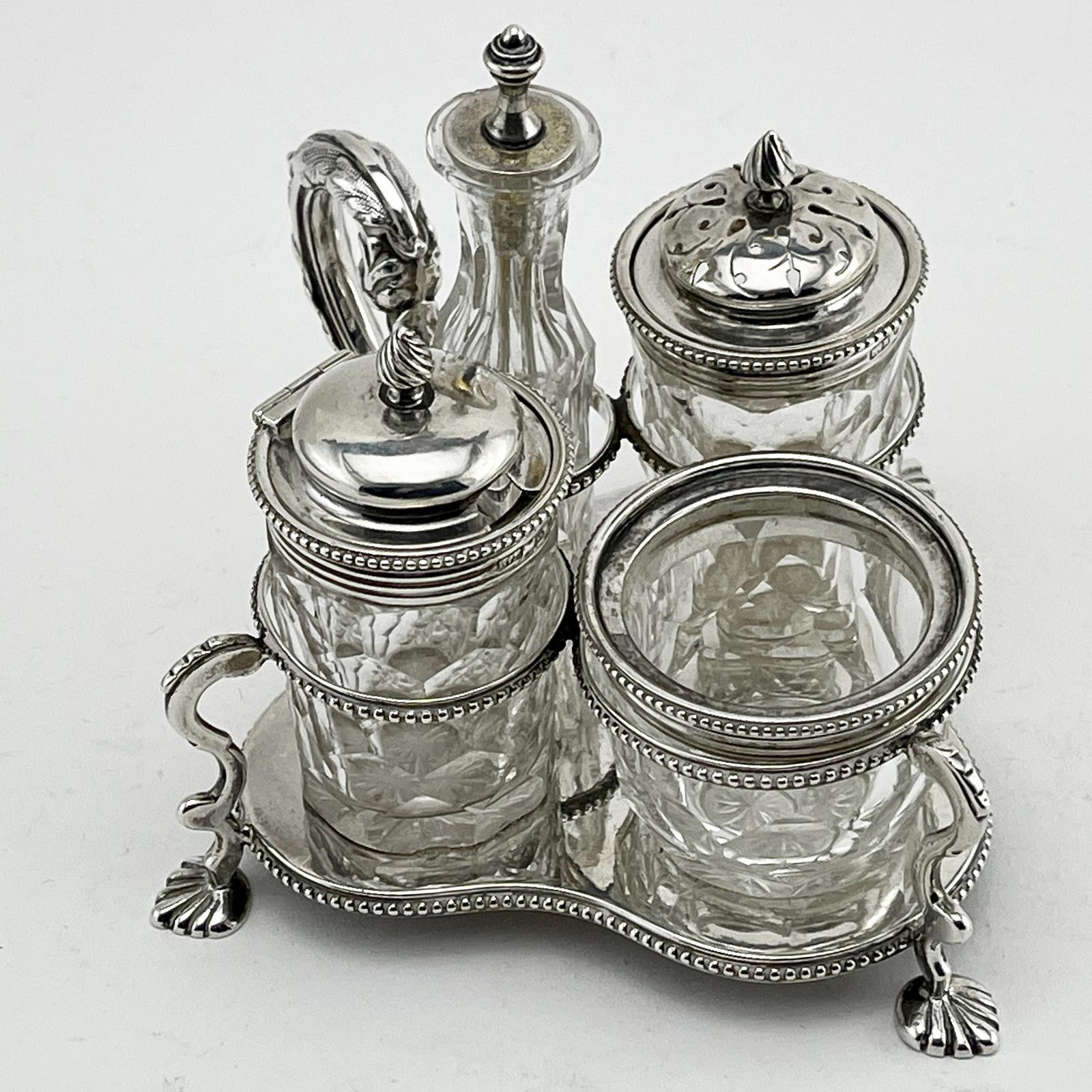Hallmarks are a great way to identify the year and silversmiths who made them. For more information on how to read hallmarks please read our 'Silver Hallmarks Explained' blog post. Few things are more timeless than a pair of beautiful Silver candlesticks or a simple elegant Silver box. Alongside these are more practical items such as Silver spoons and Silver cases that are still perfect for use. If you want something with the practicality and look without the price then Silver Plate has always been an excellent choice as well.
At LoveAntiques we offer one of the best selections of Antique and vintage Solid Silver and Silver Plate on the internet shop with confidence from hundreds of antiques dealers.
Piers Rankin Silver Antiques
Victorian Sterling Silver Four Bottle Cruet or Condiment Set
£ 375
Victorian Sterling Silver Four Bottle Cruet or Condiment Set
£ 375
Piers Rankin Silver Antiques
Piers Rankin Silver Antiques
Good Quality Irish Sterling Silver Mustard Pot
£ 220
Piers Rankin Silver Antiques
Pretty Boxed Sterling Silver Butter Dish and Spoon
£ 245
Piers Rankin Silver Antiques
Pretty George Unite Sterling Silver Card Case
£ 240
Piers Rankin Silver Antiques
Unusual Chester Sterling Silver String Box
£ 320
Piers Rankin Silver Antiques
Good Quality and Gauge Sterling Silver Hip Flask
£ 385
Piers Rankin Silver Antiques
Victorian Charles Stuart Harris Sterling Silver Mustard Pot
£ 225
Victorian Charles Stuart Harris Sterling Silver Mustard Pot
£ 225
Piers Rankin Silver Antiques
Piers Rankin Silver Antiques
Good Quality William Comyns Sterling Silver Photo Frame
£ 160
Piers Rankin Silver Antiques
Sterling Silver Cigar or Trinket Box with Heavy Gauge Silver
£ 785
Sterling Silver Cigar or Trinket Box with Heavy Gauge Silver
£ 785
Piers Rankin Silver Antiques
Piers Rankin Silver Antiques
Antique Nathan & Hayes Chester Sterling Silver Mustard Pot
£ 240
Piers Rankin Silver Antiques
Unusual Edwardian Style Plain Sterling Silver Photo Frame
£ 295
Piers Rankin Silver Antiques
Edwardian William Comyns Silver Topped Perfume Bottle
£ 285
Piers Rankin Silver Antiques
Pretty George Unite Victorian Sterling Silver Goblet
£ 550
Piers Rankin Silver Antiques
Georgian Henry Chawner Sterling Silver Cream Jug
£ 245
Piers Rankin Silver Antiques
Unusual Ecclesiastical Church Sterling Silver Salver
£ 375
Piers Rankin Silver Antiques
Late Victorian Rectangular Sterling Silver Photo Frame
£ 270
Piers Rankin Silver Antiques
Floral Pattern Enamel and Sterling Silver Hand Mirror
£ 245
Piers Rankin Silver Antiques
Ornate Early Victorian Sterling Silver Mustard Pot
£ 345
Piers Rankin Silver Antiques
Stylish Victorian Sterling Silver Rectangular Photo Frame
£ 285
Piers Rankin Silver Antiques
Liberty & Co Sterling Silver and Enamel Napkin Ring
£ 240
Piers Rankin Silver Antiques
Good Quality Early Victorian Sterling Silver Mustard Pot
£ 335
Piers Rankin Silver Antiques
Edwardian Sterling Silver and Leather Hip Flask
£ 350
Piers Rankin Silver Antiques
Smart Sterling Silver Plain Christening Mug
£ 235
Piers Rankin Silver Antiques
Cedar Lined Sterling Silver Cigarette or Trinket Box
£ 295
Piers Rankin Silver Antiques
Good Quality Sterling Silver Tea Strainer
£ 185
Piers Rankin Silver Antiques
Elegant Pair Edwardian Sterling Silver Candlesticks
£ 325
Piers Rankin Silver Antiques
Pierced Victorian Sterling Silver Mustard Pot
£ 335
Piers Rankin Silver Antiques
Decorative Victorian Silver Plated Trophy Cup
£ 285
Piers Rankin Silver Antiques
Good Quality Sterling Silver Cigar or Trinket Box
£ 435
Piers Rankin Silver Antiques
Charming Edwardian Sterling Silver Photo Frame
£ 290
Piers Rankin Silver Antiques
Impressive 25.4cm (10") Victorian Silver Plated Trophy Cup
£ 285
Piers Rankin Silver Antiques
Elegant Pair Georgian Style Sterling Silver Candlesticks
£ 650
Piers Rankin Silver Antiques
Beautiful Large Sterling Silver Photo Frame
£ 420
€ 590
€ 590
€ 490
Antique Solid Silver Pocket Watch - Signed Mazzantini - Switzerland ca.1890
€ 490
IberAntiques
€ 390
Antique 15 Jewel Pocket Watch with Engraved Silvered Case - Switzerland 1880–1890
€ 390
IberAntiques
Highland Antiques Limited
George IV Antique Set of 4 Silver Salt Bowls - London 1827
£ 1,295
George IV Antique Set of 4 Silver Salt Bowls - London 1827
£ 1,295
Highland Antiques Limited
Queens Antiques & Collectables
George III Large Oval Silver Gilt Vinaigrette Bham 1798 Ford & Slater *RARE*
George III Large Oval Silver Gilt Vinaigrette Bham 1798 Ford & Slater *RARE*
Queens Antiques & Collectables
Queens Antiques & Collectables
George III Sterling Silver Patch Pill Box Joseph Taylor Birmingham 1810
£ 155
George III Sterling Silver Patch Pill Box Joseph Taylor Birmingham 1810
£ 155
Queens Antiques & Collectables


